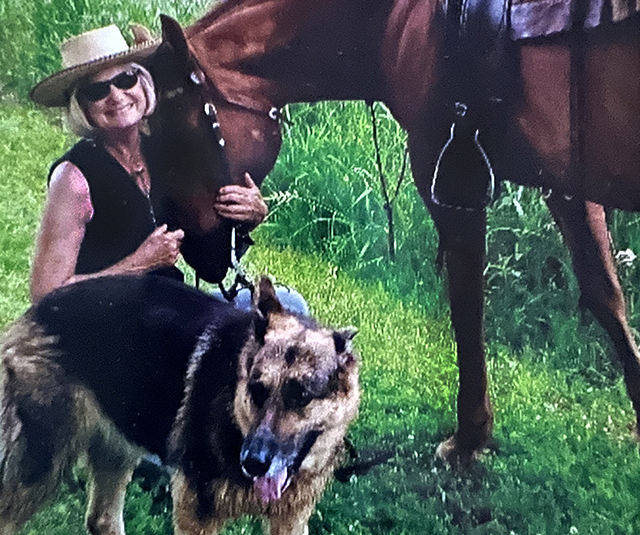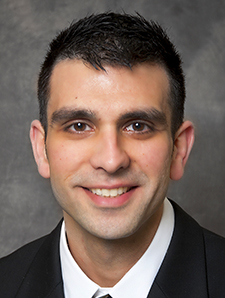Five years ago, Nancy Skoog-Edholm had no idea that she had two brain aneurysms. Then she started feeling sick.
“I had a really bad headache,” she recalled. “I felt really weak. I took my blood pressure and it was really, really high.” When a CT scan of her brain revealed the aneurysms, Skoog-Edholm, who has a strong family history of the disorder — her grandmother, cousin and aunt all died of ruptured aneurysms before age 56 — was rushed by ambulance to Abbott Northwestern Hospital in Minneapolis.
At Abbott, Dr. Yasha Kayan, a neurointerventional radiologist, met Skoog-Edholm in the emergency room. He told her she would need to get a lumbar puncture to determine if her aneurysms had ruptured — a potentially fatal situation. If blood was present in her spinal fluid, that would be an indication of rupture.
The lab found that there was no blood in Skoog-Edholm’s spinal fluid, but they did discover that she had viral meningitis. This condition, while serious, was unrelated to the aneurysms — but it helped alert doctors to their presence.
Because brain aneurysms often present little or no symptoms, it is not uncommon for them to be discovered during testing for unrelated health conditions. Because a ruptured brain aneurysm can be life-threatening, finding an unruptured one presents a rare chance to treat the condition before it becomes an emergency, Kayan explained: “A lot of patients end up seeing it as a lucky thing that they went looking for something else and found an aneurysm.”
Kayan told Skoog-Edholm that because her aneurysms were unruptured she could wait for her meningitis to resolve before commencing treatment. He explained that when she was feeling better, he’d fill her smaller aneurysm with a coil, a less-invasive endovascular procedure developed in the mid-1990s. Kayan placed a series of soft platinum coils in her smaller aneurysm that slowed blood flow and created a clot that allowed a new blood vessel to form. The procedure, which involves some level of risk for stroke, was successful and took about three hours to complete.


Kayan knew about another option that he hoped to use on Skoog-Edholm’s larger aneurysm — the Woven EndoBridge, or WEB device. It was on track for FDA approval but wasn’t yet available.
The WEB device, Kayan explained, works “a little bit differently” than a coil procedure. Rather than inserting a bunch of small coils, the WEB is a single device, a mesh basket that comes out of microsheath in a collapsed state and then opens into an aneurysm like a flower, hugging its walls. While coils sometimes fall out and cause risk of stroke or hemorrhage, Kayan said, the WEB device stays put: “It serves as an easier scaffold for a vessel wall.”
Because the WEB device works quickly and fills the artery more completely, Kayan said, patients benefit in a number of ways. “They have less time under anesthesia, less chance for clot forming on our devices and plugging up a normal brain artery. There is less chance of stroke.” He believed that Skoog-Edholm was a good candidate for the procedure.
When the FDA granted approval for the WEB device a few months later, Kayan called Skoog-Edholm and gave her the good news.
“I was excited to hear this,” Skoog-Edholm said. While coil treatment for her first aneurysm went smoothly, her recovery from the procedure took time. She was hoping for an easier outcome the second time around.
At Abbott, first choice
At Abbott Northwestern, Kayan and his neurointerventional radiology colleagues now consider the WEB device their first choice for aneurysm treatment. While Kayan said a lot of medical practices still see WEB as a “much more niche device for specific situations,” he and his team see it as a game-changer that has improved the outlook for a broad spectrum of aneurysm patients.
“We’ve used it in numerous types of anatomies,” he said. “The reason we do it is it is so safe compared to other techniques. With experience we’ve found it works in a wide variety of situations.”
Beyond the benefit of shorter surgical times (“You can go in, deposit a single device oftentimes within 30 or 40 minutes, and you’re done,” he said), Kayan added that the WEB device’s safety profile compared to that of coils is also appealing. Whereas brain aneurysms before came with a 2% to 3% stroke risk and highest-risk aneurysms had a 5% stroke risk, he said, “With the WEB device, the risk of a major stroke is less than one percent.”
Brain aneurysm is more common than most people think, Kayan said. He explained that every year doctors discover around 30,000 ruptured brain aneurysms. But because most brain aneurysms don’t rupture, he said, he and his colleagues work with patients to help them understand the risks and benefits of treatment.
“Some aneurysm we know have a low risk of rupture,” Kayan said. “With those, we say the chance is small and it’s probably not worth going through the treatment.” Patients at low risk of rupture are put on the practice’s surveillance program. With patients at intermediate risk of rupture like Skoog-Edholm, they recommend treatment.
Back to normal
For Skoog-Edholm, the news that she had two brain aneurysms was frightening. “I was walking on eggshells,” she said. “I was constantly monitoring my blood pressure, always trying to keep myself safe.”
An avid horseback rider, she said she kept her feet on the ground until procedures were completed for both aneurysms. While she needed to give herself extra time to rest and feel better after her coil procedure, she said that after the WEB device was in place, she felt normal quickly and ready to get back in the saddle.
“I’m back to riding my horse,” Skoog-Edholm said. “The procedure went so smoothly. I felt less groggy and tired than I did with the first one. And the pain was minimal.”
Because Skoog-Edholm’s risk of stroke or other side-effects from these procedures is relatively low, Kayan has her scheduled for annual MRI checks to confirm the aneurysms stay resolved. Other than that, she said she feels like this disturbing chapter of her life is now closed.
“After I get my MRI,” Skoog-Edholm explained, “Dr. Kayan looks at it and then he gets back to me with a letter.” In the years since the procedures, Skoog-Edholm said she’s mostly been able to set her worries aside: “A lot of times I don’t even think about it anymore. I’d much rather be out riding my horse.”

0 Commentaires